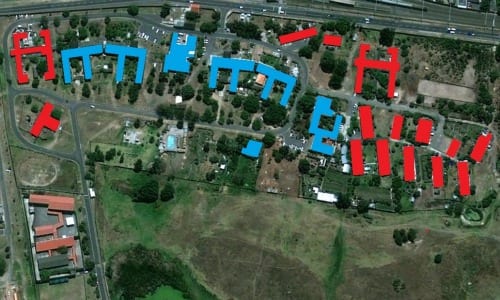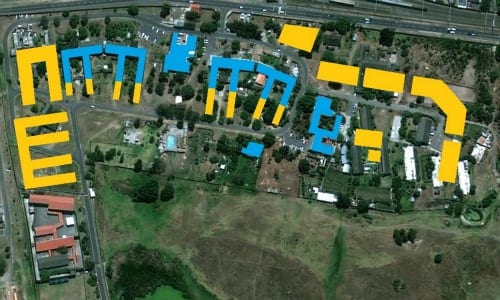Results: Visions and Rationale
This section describes the stages of design and illustrates the layout to best maximize the available area and demonstrate how the Eco Village can grow into a vibrant, multi-purpose space.
The buildings highlighted in the left-hand image in Figure 1 represent the major building footprint currently existing in Oude Molen. We examined these major building footprints while constructing our virtual model to determine which we could expand on. The buildings outlined in red represent buildings we removed in our model and include prefabricated, uninhabitable buildings as well as those that do not have the foundation to support more floors. The remaining seven blue buildings were either preserved or renovated in our model.
The right-hand image is a representation of the changes that were made in our model. The blue blocks still represent the preserved or renovated buildings, while the yellow represents those structures that were added in our model.
Building Location and Orientation
To preserve the unique atmosphere of Oude Molen, we sought balance between open space and built environment. This balance was achieved through configuring a spatial layout of the property, tailored to the social and community dynamics. We separated the village into three distinct zones: residential, commercial, and multi-purpose area. The residential area is located in the southern corner of the property to separate it from the businesses, to allow for a more secluded living space. The location of the buildings optimizes for the view of the river/wetlands and Devil’s Peak while also protecting the residential recreation area from strong south-easterly winds. The commercial sector is located on the northern border of Oude Molen with the multi-purpose area located in the middle of the community. The multi-purpose area contains the recreation corridor, community centre, museum, and four pre-existing renovated buildings that will house commercial enterprises on the ground floor and residential units on the first and second floors.
These existing and planned graphs demonstrate the changes in ground area that various parts of Oude Molen occupy. The change of the building footprint displayed in the chart is an increase of only 37%. The open space has only decreased by 17% this constituting a decrease of 13,870 m2. The increase slightly changes the amount of open space while generating rents sufficient to allow OMEV to be economically self-sustaining.
Live and Work
There are four buildings in Oude Molen that we renovated in our model. We adopted OMEV’s commitment to a “live and work” concept within the village in which employees live in very close proximity to their work areas. This concept reduces the carbon footprint by reducing the need for transportation. In our vision, living quarters will be on the first and second floors while the commercial space will be on the ground floor. The model also includes apartments in a separate residential section close enough to the commercial area to embody the live and work concept.
In order to optimize the available space, renovations were included to expand the length of the building and raise it one level to double the residential space. The extensions on the ends of the building are about 20 metres long to increase the commercial space. The added second floor is comprised of glass to minimize stress on the foundation of the building, creating a new floor at an inexpensive cost. On the outside walls a balcony was added to provide access to the first story, as well as to serve as protective covering for shops to extend beyond the building. Having the balcony on the exterior of the building will also prevent the need for hallways or staircases within the building. The second floor will be used for multiple-story apartments.
Roof
 Another significant aspect of these buildings was the roof design. It covers the courtyard area, protecting it from rain and wind, while creating an open atmosphere. We analyzed over a hundred different design options to find one that best incorporated feasibility, functionality, and aesthetic appeal. Using a single roofing design throughout the model unifies the old and new buildings. This roof will be comprised of “Building Integrated Photovoltaics,” a material that integrates solar panels into the structure in order to increase energy efficiency, provide power generation, and allow sunlight to enter. For more information click here.
Another significant aspect of these buildings was the roof design. It covers the courtyard area, protecting it from rain and wind, while creating an open atmosphere. We analyzed over a hundred different design options to find one that best incorporated feasibility, functionality, and aesthetic appeal. Using a single roofing design throughout the model unifies the old and new buildings. This roof will be comprised of “Building Integrated Photovoltaics,” a material that integrates solar panels into the structure in order to increase energy efficiency, provide power generation, and allow sunlight to enter. For more information click here.
Commercial Sector
The commercial buildings continue the structural style of the existing buildings, but are designed larger in size in order to maximize space. In our model, we visualized the bottom floors consisting of enterprises such as restaurants and craft stores that will expand into the courtyard. Businesses that do not involve direct consumer interaction will be located on the upper floors. The buildings are designed to allow flexibility for micro-enterprises. With main utility lines running the length of the building, all businesses will have the option to expand or decrease the area needed for their enterprises simply by changing the placement of the non-load bearing walls.
With these additional buildings, Oude Molen will be able to host a hundred micro-enterprises including twelve Non-Governmental Organizations and educational institutions. This will create roughly 500 jobs for residents of Oude Molen and surrounding communities. Job shadowing and other educational programs would allow youth to develop the skills needed to create a sustainable living for themselves.
Residential Sector

The residential section will consist of four buildings located where the prefabricated buildings currently reside. These buildings, in addition to the upper floors of the existing buildings, will be able to accommodate 600 apartment units which will house approximately 1,500 people. To provide privacy, the residential section is separated from the commercial area.
The available apartments vary from a bachelors’ suite at 35 square meters to three bedroom apartments at 100 square metres. These apartments will vary in price depending upon location in the building, holding potential for mixed income living. For more information click here.
Parking
In our model, we planned to accommodate about 1,500 people; a sizeable parking area was needed to fulfil both commercial and residential needs. One parking space was allocated for each residential unit, while each commercial enterprise was designated an average of five spaces resulting in six hundred spaces for residential units and five hundred spaces for commercial enterprises. For events such as craft markets, musical and other cultural events, we proposed parking be located outside the premises. It would best suit the aesthetic appeal of Oude Molen to not accommodate the large number of automobiles that such events would attract. There is a stretch of provincial land outside of Oude Molen that could be utilized to account for the influx of people.
Parking was considered early on in the design process due to the size limitations of the property and projected number of cars that will be in the village. We considered many parking options such as parking structures and underground parking. The addition of a parking structure was considered because it would allow for a large number of cars to be held in an area that would occupy a smaller ground footprint. Another option considered was to implement underground parking in scattered areas around Oude Molen and underneath buildings. However, parking structures and underground parking were not economically viable, so parking areas were all accounted for on the ground level. For more information click here.
Bio-digester
In keeping with the theme of sustainability, we integrated a bio-digester in one of the parking areas, creating a multi-purpose space. The bio-digester would be located underground and would absorb sewage and organic waste, which will produce methane, electricity and grey water. The digester will be able to accommodate 5,000 people, which includes the population of OMEV, Maitland Garden Village, and the tourist influx.
Education
The building and play area of the Gaia Waldorf School currently in Oude Molen will be relocated next to the farmhouse, closer to the residential buildings to seclude it from the busy commercial area, and make it convenient for families living in the residential buildings. It will be expanded to account for the projected population increase. A crèche will also be added next door with its own playground. Areas such as the school, community centre, gardens, and other designated recreational areas can be utilized for future youth programmes. These programs would foster a sense of community and inspiration for future generations.
Recreation Corridor

We wanted to create a community with a diverse public space encouraging social and communal development. The recreation corridor will be the focal point for community activity; including a picnic area with tables and grills for family and other social activities, as well as a playground for kids to enjoy themselves. The amphitheater is able to host a large audience of over a thousand people, for various types of plays, music and cultural events; it would blend right in with the environment because of the sloping topography. The pool area will be revamped with new buildings, such as changing rooms, toilets, and snack shack. The horses, which constitute an important part of Oude Molen, will be located in the recreation corridor during the day and stay in paddocks on the edge of the Oude Molen property at night. The location of the daytime paddocks was chosen to attract tourists and enhance the natural aesthetics of Oude Molen.





